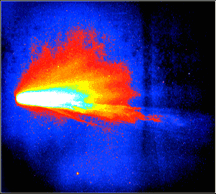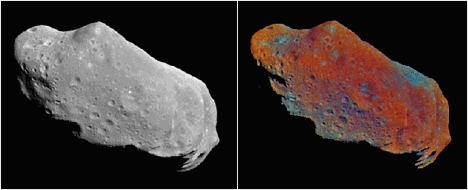![]()
The term "false color" is used to describe what astronomers (and others) often do to images to make them more comprehensible. Long ago, when radio astronomers first started generating images of sources, they wound up with essentially images that were just shades of gray - ranging from pure black to pure white. Each shade represented the intensity of the radio emission from a particular part of the object. Radio astronomers took their shades-of-gray images and converted them to color ones by assigning red to the most intense radio emission and blue to the least intense emission recorded on the image. Intermediate colors (orange, yellow, and green) were assigned to the intermediate levels of radio intensity. Black was assigned to places in the image in which there appeared to be no radio emission.

|
|
False Color Image of Comet Halley |
This process allows astronomers to more quickly recognize features in the images. Typically, when looking at a photograph, the human eye can only distinguish about 16 shades of gray from one another. Using millions of colors, instead, we can often bring out details in an image that we might otherwise miss. These days, just about every area of astronomy creates "false color" images. Remember - electromagnetic radiation does not have "real" color except for the radiation that has a wavelength of between 400 and 700 nm. That little range is called the "visible" spectrum, since it is what we humans beings see with our eyes!
Below on the left, you see the actual image of the asteroid Ida taken by NASA's Galileo satellite. On the right, you see a false color version of the same image. The features colored blue are now quite apparent. They are believed to represent "young" terrain on this ancient object.
 >
>
![]()
The StarChild site is a service of the High Energy Astrophysics Science Archive Research Center (HEASARC), within the Astrophysics Science Division (ASD) at NASA/ GSFC.
StarChild Authors: The StarChild Team
StarChild Graphics & Music: Acknowledgments
StarChild Project Leader: Dr. Laura A.
Whitlock
Curator:
Responsible NASA Official: